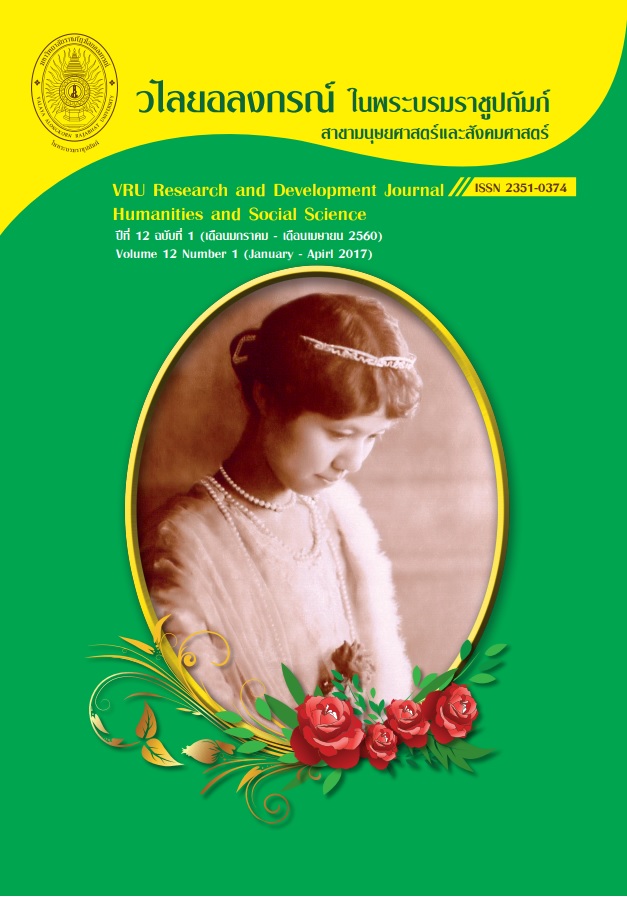การศึกษาผลการให้คะแนนรายวิชาปฏิบัติการพยาบาลมารดาทารกและการผดุงครรภ์ 2 ในอาจารย์ผู้สอนภาคปฏิบัติที่มีประสบการณ์การสอนแตกต่างกัน
Main Article Content
Abstract
การวิจัยนี้มีวัตถุประสงค์เพื่อ 1) ศึกษาความคลาดเคลื่อนแบบกด ปล่อยคะแนน 2) ศึกษาความสอดคล้องในการประเมินของอาจารย์ผู้สอนภาคปฏิบัติ ประชากรคืออาจารย์ผู้สอนภาคปฏิบัติ 6 คน ที่สอนนักศึกษาพยาบาล ชั้นปีที่ 3 รายวิชาปฏิบัติการพยาบาลมารดา ทารกและการผดุงครรภ์ 2 ภาคการศึกษาที่ 2 ปีการศึกษา 2555 เครื่องมือที่ใช้คือ 1) แบบประเมินภูมิหลังของผู้ประเมิน และ 2) รูบริคการประเมินผลการปฏิบัติการพยาบาล 5 ระดับ วิเคราะห์โดย ร้อยละ ค่าเฉลี่ย ส่วนเบี่ยงเบนมาตรฐาน และประมาณค่าความคลาดเคลื่อนจากผู้ประเมินด้วยวิธีของกิลฟอร์ด วิเคราะห์ความสอดคล้องกันระหว่างผู้ประเมินด้วยค่า intraclass correlation coefficient: ICC (3.3) (95% CI) ผลการวิจัยคือ อาจารย์ที่หน่วยห้องคลอด 3 คน และหน่วยหลังคลอด 3 คนมีประสบการณ์การสอนภาคทฤษฎีแตกต่างกัน 3 กลุ่ม คือไม่เคยสอนภาคทฤษฎี มีประสบการณ์น้อยกว่า 3 ปี และมากกว่า 3 ปี แต่ทุกคนมีประสบการณ์การสอนภาคปฏิบัติ และมีทัศนคติต่อการสอนในคลินิกในระดับปานกลาง ผลการประเมินคะแนนการฝึกปฏิบัติงานพิจารณาจากค่าเฉลี่ยและส่วนเบี่ยงเบนมาตรฐาน ที่หน่วยห้องคลอด พบว่าอาจารย์คนที่ 1 และ2 มีการกดคะแนนคนที่ 3 มีการปล่อยคะแนน ที่หน่วยหลังคลอดพบว่า อาจารย์คนที่ 1 มีการกดคะแนน คนที่ 2 และ 3 มีการปล่อยคะแนน เมื่อวิเคราะห์ด้วยวิธีของกิลฟอร์ดให้ผลการวิเคราะห์สอดคล้องกันทั้งสองหน่วยฝึก ผลการวิเคราะห์ความสอดคล้องระหว่างผู้ประเมิน ที่หน่วยห้องคลอด พบว่าสมรรถนะส่วนใหญ่ มีค่า ICC ติดลบ ยกเว้นสมรรถนะด้านความสามารถในการปฏิบัติกิจกรรมพยาบาลมีความสัมพันธ์ระดับปานกลาง ICC =0.44 (CI= -0.04 - 0.72) และหน่วยหลังคลอดทุกสมรรถนะมีค่าติดลบ ยกเว้นจรรยาบรรณวิชาชีพ มีความสัมพันธ์ระดับต่ำมาก ICC = 0.04 (95.00% CI=-1.65-0.03) แสดงว่าในภาพรวมคะแนนการประเมินระหว่างผู้ประเมินมีความไม่สัมพันธ์กัน
The purposes of this study were: (1) to investigate rater effects, leniency, stringency error (2) to demonstrate the inter-rater agreement among the instructors. Population were six instructors with vary in experience of instruction the 3 rd year student nurses who enrolled in practicum in maternal newborn and midwifery II course in 2 nd semester of 2012. The Instruments were 1) the background of rater assessment questionnaire, 2) the 5 level of scoring rubrics for evaluating nursing outcome. Percent, mean, standard deviation, estimating of leniency/stringency error by means of Guilford (1954) Intraclass correlation coefficient: ICC (3.3) (95% CI) were employed. The results concluded that the clinical instructors’ background were vary in 3 groups from no experience, less than 3 years and more than 3 years of experience in theoretical teaching, but all had experience in clinical teaching and had moderate attitude to clinical teaching. By means of mean and standard deviation rater 1 and rater2 at delivery room setting had stringency error, rater 1 was more stringency than rater2, but rater 3 was leniency. At postpartum care unit, rater 1 was stringency but rater2 and rater3 were leniency. Comparing to means of Guilford the results were presented accordingly at both setting. The inter-rater agreement among raters on six competency: competency of using nursing process, competency of nursing intervention, communication competency, nursing ethics and self- improvement at delivery room setting, most of them were demonstrated negative value of ICCs. Except for competency of nursing intervention was fair ICC =0.44 (95.00% CI=-0.04-0.72). At postpartum care setting, all competency were negative value of ICCs, but for nursing ethics was very poor ICC = 0.04 (95.00% CI=-1.65-0.03). In conclusion, the rating results were not in accord with each other.
Article Details
ลิขสิทธิ์บทความวิจัยที่ได้รับการตีพิมพ์เผยแพร่ในวารสารมนุษยศาสตร์และสังคมศาสตร์ วไลยอลงกรณ์ ในพระบรมราชูปถัมภ์ ถือเป็นกรรมสิทธิ์ของคณะมนุษยศาสตร์และสังคมศาสตร์ มหาวิทยาลัยราชภัฏวไลยอลงกรณ์ ในพระบรมราชูปถัมภ์ ห้ามนำข้อความทั้งหมดหรือบางส่วนไปพิมพ์ซ้ำ เว้นแต่จะได้รับอนุญาตจากมหาวิทยาลัยเป็นลายลักษณ์อักษร
ความรับผิดชอบ เนื้อหาต้นฉบับที่ปรากฏในวารสารมนุษยศาสตร์และสังคมศาสตร์ วไลยอลงกรณ์ ในพระบรมราชูปถัมภ์ เป็นความรับผิดชอบของผู้นิพนธ์บทความหรือผู้เขียนเอง ทั้งนี้ไม่รวมความผิดพลาดอันเกิดจากเทคนิคการพิมพ์
References
จีราภา คงสมฤทธิ์. (2544). การพัฒนาแบบประเมินการสอนภาคปฏิบัติในคลินิกของอาจารย์พยาบาล. วิทยานิพนธ์ปริญญาศึกษาศาสตร์มหาบัณฑิต คณะศึกษาศาสตร์ มหาวิทยาลัยเกษตรศาสตร์.
ปิยะรัตน์ หยกสุริยันต์, 2549 ปรัชญา ไทยแท้. (2550). การพัฒนาแบบประเมินสมรรถนะของพยาบาลวิชาชีพ โรงพยาบาลราชวิถี. วิทยานิพนธ์พยาบาลศาสตรมหาบัณฑิต คณะพยาบาลศาสตร์ จุฬาลงกรณ์มหาวิทยาลัย.
อนัญญา คูอาริยะกุล. ( 2554). การพัฒนารูปแบบการประเมินการฝึกภาคปฏิบัติสำหรับนักศึกษาพยาบาลสังกัดสถาบันพระบรมราชชนก. วิทยานิพนธ์ปริญญาการศึกษาดุษฎีบัณฑิต คณะศึกษาศาสตร์ มหาวิทยาลัยนเรศวร.
Barkaoui, K. (2010). Do ESL essay raters' evaluation criteria change with experience? A mixed-methods, cross-sectional study. TESOL Quarterly, 31-57.
Donaldson, J.H.,and Gray, M. (2012). Systematic review of grading practice: is there evidence of grade inflation?.Nurse education in practice, 12: 101-104.
Guilford, J. P. (1954). Psychometric methods (2nd ed.). New York : McGraw-Hill.
Hallgren, K. A. (2012). Computing inter-rater reliability for observational data: an overview and tutorial. Tutorials in quantitative methods for psychology, 8(1), 23.
Johnson, R. L., Penny, J. A., & Gordon, B. (2008). Assessing performance: Designing, scoring, and validating performance tasks: Guilford Press.
Kaufman, J. C., Baer, J., Cole, J. C., & Sexton, J. D. (2008). A comparison of expert and nonexpert raters using the consensual assessment technique. Creativity Research Journal, 20(2), 171-178.
Lim, G. S. (2011). The development and maintenance of rating quality in performance writing assessment: A longitudinal study of new and experienced raters. Language Testing, 28(4) 543 –560.
Reynolds, C. R., Livingston, R. B., & Willson, V. L. (2009). Measurement and assessment in education. Upper Saddle River:Pearson Merrill Prentice Hall.
Rousson, V., Gasser, T., & Seifert, B. (2003). Confidence Intervals for Intraclass Correlation in Inter‐Rater Reliability. Scandinavian journal of statistics, 30(3), 617-624.
Sweedler-Brown, C. O. (1985). The influence of training and experience on holistic essay evaluation. English Journal, 74, 49-55.
Wolfe, E. W. (2004). Identifying rater effects using latent trait models. Psychology Science, 46, 35-51.

